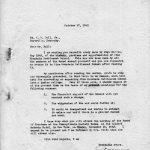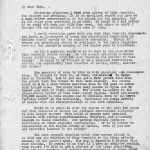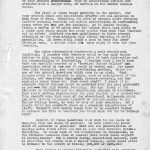Pine Mountain Settlement School
Series 07: Directors – Glyn Morris
Series 09: Biography – Glyn Morris
Series 13: Education
GLYN MORRIS STUDY & RECOMMENDATIONS XI Board Responses 1942
TAGS: Glyn Morris Study & Recommendations – Board Responses 1942; Pine Mountain Settlement School; Harlan County, KY; correspondence; Board of Trustees; students; community; Harlan County, KY; planning; feasibility of expanding the School locally; feasibility of changing the School to a junior college; effects of WWII on decisions;
GALLERY: Glyn Morris Study & Recommendations XI Board Responses 1942
- 01 Letter regarding circulation of Morris Study to Trustees. Glyn Morris Study & Recommendations – Board Responses 1942. [morris_study_review_001.jpg]
- 02 Response from C.N. Manning to Morris Study. Glyn Morris Study & Recommendations – Board Responses 1942. [morris_study_review_002.jpg]
- 03 Response from Evelyn K. Wells to Morris Study. Glyn Morris Study & Recommendations – Board Responses 1942. [morris_study_review_003.jpg]
- 04 Response from Paul Cressey to Morris Study, page 1. Glyn Morris Study & Recommendations – Board Responses 1942. [morris_study_review_004.jpg]
- 05 Response from Paul Cressey to Morris Study, page 2. Glyn Morris Study & Recommendations – Board Responses 1942. [morris_study_review_005.jpg]
TRANSCRIPTION: Glyn Morris Study & Recommendations – Board Responses 1942
[Slightly edited.]
[morris_study_review_001.jpg]
STUDY MADE BY GLYN MORRIS – MAY 1942
This study has already been seen by the following members of the Board of Trustees:
Miss [Evelyn K. ] Wells
Mr. Swift
Dr. Van Vleck
Mr. Crutchfield
It is requested that it be circulated as promptly as possible in the following order:
Mrs. Leonard [Dorothy] Elsmith
Woods Hole, Mass. [Handwritten notation: “already seen by Mrs. Elsmith”]
Mrs. Ingram D. [Mary Rockwell] Hook
Summit Street
Kansas City, Mo.
Mrs. Anderson Gratz
North Hill Street
Lexington, Ky.
Mr. C.N. Manning
Security Trust Company
Lexington, KY
Mr. W.W. Ball
State National Bank
Maysville, Ky.
Mr. Ball is requested to return the study to Pine Mountain Settlement School.
[Signed] Harriet Crutchfield
Harriet Crutchfield
(for Miss Wells)
Pittsburgh, July 23, 1942.
[morris_study_review_002.jpg]
SECURITY TRUST COMPANY
LEXINGTON, KY.
October 27, 1942
Mr. W.W. Ball, Jr.,
Maysville, Kentucky.
Dear Mr. Ball:
I am sending you herewith study made by Glyn Morris, May 1942, of the history, problems and opportunities of Pine Mountain Settlement School. This has now been seen by all the members of the Board except yourself and you are requested to return it to Pine Mountain Settlement School after reading it.
My conclusion after reading the survey, which is ably and thoroughly presented, is that there is no demand, much less need for converting or expanding Pine Mountain Settlement School into a junior college. Even if there were, I should oppose it at the present time on the basis of my present knowledge for the following reasons.
1. The financial support of the School will not warrant such a change;
2. The exigencies of the war would forbid it;
3. It would be inexpedient and unwise to attempt it unless and until there is a greater demand and need.
I hope very much you will attend the meeting of the Board of Trustees at the Pennsylvania Society Rooms, at the Waldorf Astoria Hotel, in New York, on Sunday, November 15, 1942. I expect to be present and I am informed by Mrs. Gratz that she will attend also.
With kind regards, I am
Cordially yours,
[Signed “CNManning”’]
C.N. Manning
[morris_study_review_003.jpg]
Shepard House, Wellesley, Mass.
June 15, 1942
Dear Mr. Morris:
I read your May 1942 Study on the train returning from the board meeting, — with the greatest interest and admiration for the analysis you have made. You have shown very clearly in some cases, and indicated in others, the reasons for our successes and failures.
But I think that instead of persuading me that the junior college is the solution for more effective service for Pine Mountain, your report demonstrates to me that we should turn in the other direction, spreading horizontally instead of vertically, as Mr. Manning said at the board meeting on Saturday, recognizing that we are placed at the head waters of the Middle Fork for a special reason, to meet the growing needs of head-of-the-hollow as it meets mining-camp, doing more community work, cooperating more with the district schools, accepting the fact that much, if not most, of our work is palliative and not constructive, taking the material at hand and working with it, instead of trying to find better. I should have to think longer about some of the reasons you adduce for trying a junior college scheme: — I doubt whether the prestige of attending a local junior college would register with many boys and girls. People out for prestige of that sort will get it by “going away” to college. If it is hard to fill the school with promising high-school age boys and girls, it will be still harder to fill it with older students.
Our greatest failure is due to the widening breach between school and community, which was beginning long before I left Pine Mountain, and which came to its most serious proportions about the time the Community Group was organized. Since then of course the situation has improved slightly. The Institute, the student visits, the greater awareness of the workers of their responsibility to the neighborhood, have set us on the right track again.
I believe also that the junior college idea is still a matter of debate and think about, for the country at large as well as for Pine Mountain. At present, almost every institution I know about is in the same state of mind, wondering whether it ought to try for more advanced, or less advanced students.
During the war and probably during the years following it, it would be unwise to make any drastic changes in our policy. I would therefore postpone till a more settled time this question, always keeping in mind the very clear way you have shown us, to developing another sort of school if and when the time comes.
Very sincerely yours,
[Signed] Evelyn K. Wells
[morris_study_review_004.jpg]
Pine Mountain, Kentucky
May 28, 1942
[handwritten notation: “From Paul Cressey”]
My Dear Glyn,
Yesterday afternoon I read your survey of Pine Mountain, its history and problems. It is an excellent report and gave me a much better understanding of the school and its program. But it did raise some questions in my mind. It would be a lot better if we could sit down and talk them over, but since we can’t I thought I’d try writing you about some of them.
I would certainly agree with you that Pine Mountain represents too large an investment of money and educational leadership to confine itself merely to its adjacent community. Though of course its advantages should be available to the local neighborhood and the community program of the Junior year is excellent.
My first question would be as to what is the area which Pine Mountain should serve. Is the school primarily a Harlan County institution, with its main function serving of this county? Or could it be thought of as a regional institution, serving the surrounding four counties of Leslie, Perry, Letcher and Harlan?
The question of area is tied up with geography and communication. My thought is that if, or when, the Harlan to Hyden road is finished, and if you can get a fair gravel road from the school down the valley to this main highway, the school would be in a much better position than in the past to serve this larger area. You would have easy access to Hyden and to Hazard and much of Perry County. The school is nearly in the geographical center of this four county region. There are nearly 180,000 people in this region and it includes some of the worst “problem areas” of the mountains, combining the rural poverty of Leslie with the disorganization of the coal counties.
Would it be possible over the course of the next ten years for Pine Mountain to become the dominant educational influence in this larger region? This would of course mean personal contacts with school superintendents, teachers, and community leaders in these counties, and perhaps regional guidance institutes or other regional conferences. Or is it better to concentrate on the single county of Harlan, even if you are not centrally located in the county?
The next general question which your survey raised in my mind was the relation of Pine Mountain to the other private schools in the general area. The map in Appendix 2 locates five such schools. It seemed to me that if I were an outsider reading your report I’d like to get a picture of the total situation; what are the programs and general characteristics of these other institutions, how do they compare with Pine Mountain, what are their probable plans for future development. I’m sure that Pine Mountain would show up very favorably in such an analysis, but nevertheless I should be interested in seeing such a general comparison. To what extent is Pine Mountain the outstanding…
[morris_study_review_005.jpg]
…institution of its type in this section of Kentucky?
As to your basic problem of the future development of Pine Mountain I can see two alternatives; either a continuation of your present type of educational service but extended over a larger area, or service at the Junior College level.
The first of these would probably be the easier, for your present plant and educational program are all adjusted to this type of work. Extending the area of service would probably involve personal contacts and active solicitation in surrounding areas where you now get few students, as in Leslie County. Within a radius of 50 miles from the school there must still be a great many young people who could profit from what Pine Mountain has to offer; students who are maladjusted in their present situation or for whom adequate high school training is still unavailable. If Berea still finds a need to keep its Lower Division open, I should think the same might be true for Pine Mountain.
The other alternative represents a real educational challenge. I suppose Pine Mountain would be the only Junior College in this region, which would give it both distinction and the responsibility of leadership. I confess that I don’t know what the specific content of a “terminal Junior College” curriculum would be nor how it could be worked out. But apart from this technical, and very fascinating problem, there are one or two general questions which come to my mind. What changes would be necessary in plant, such as enlargement of the library, new vocational equipment, science material, and how expensive would these be? What about staff? I doubt if an adequate Junior College could be operated with the same personnel as you use for High School teaching. The age level of the students is different and the educational content is different. What about meeting requirements for your faculty to be accredited? This doesn’t mean that much of the educational philosophy which you have already developed couldn’t be carried across to the Junior College level, as well as many of your teachers. But I should think you couldn’t count on a complete transference of staff. Wouldn’t your salary scale have to be somewhat higher to attract the kind of teachers you would want for Junior College work?
Several of these questions come back to the costs of changing from one level to another. Is this something about which an estimate is possible? What are the probabilities of raising extra funds after the war is over from Northern Philanthropists, or could some of the foundations be interested, as the Robinson Mountain Fund or others? What about local support in Harlan County? For a really daring educational venture, such as providing the county with a Junior College, could local pride be aroused to the extent of raising $50,000 or $100,000?
It seems strange to be at Pine Mountain and not find you here. I hope you are finding your Army service worth while.
[handwritten notation] “Yours as always, Paul”
See Also:
GLYN MORRIS Biography
GLYN MORRIS STUDY & RECOMMENDATIONS [FOR PMSS] 1942






